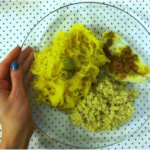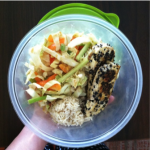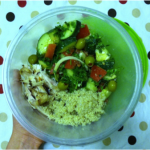Strategies for making healthy food in a hotel room
On my last guest blog post, I wrote about ways to help you eat healthy when you are on a road trip. If you recall from this post, my job requires full time traveling throughout the country; therefore, I live in a new hotel every six weeks. Out of the past 11 months, I spent nearly six of them living in a hotel with no kitchen. This has helped me become very flexible, as I’ve learned to make full meals in tight places with no kitchen, limited appliances and very few ingredients. In this post, I’d like to share with you ideas on simple meals that can come in handy when you are in similar scenarios, as well as if you simply want to quickly put together meals during a busy work week.
Working with limited appliances is challenging, but not impossible. Aside from the microwave and mini refrigerator my coworkers and I are guaranteed to have in our rooms, I have two appliances that I travel with: a small blender and a slow cooker. For the purpose of this article, I will include recipes that can be easily made using only these three appliances:
- Small blender: My choice is the Magic Bullet, but similar versions can be purchased at a department store starting at just $20.
- Slow Cooker (Crock pot): One with a timer can come in handy; however, it’s not a problem if yours doesn’t have one, it’ll just require a little more time management. Small slow cookers can be purchased for as low as $10!
- Microwave: Make sure you have microwave-safe glass or ceramic dishes to make the best use of your microwave. When traveling, inexpensive plates can be purchased at a thrift or dollar store and disposed of as needed.
Using these space savvy, affordable, user-friendly, and relatively mess-free appliances, you can make complete meals quickly and effectively. To make your meal well-balanced, you can use the USDA’s MyPlate, which guides you on what and how much to pick from each of the following food groups:
Grains
- Quinoa, rice, bulgur, oats, and wheat berries are grains you can actually make in a slow cooker or a microwave. When deciding which to use, choose appropriately. The slow cooker takes 6-8 hours of little attention, while the microwave is
much faster, but can be tricky and requires awareness. Whole grains can be used as part of breakfast like this Carrot Cake and Zucchini Bread Oatmeal, as a side dish with lunch or dinner, a mixed dish, a cold salad, or soups.
- Breads, wraps, or pitas made out of whole grain require no preparation and can be filled with endless possibilities for easy on-the-go sandwiches.
- Pastas work well in the slow-cooker; just make sure you use a watery sauce to ensure the noodles are moistened.
Vegetables
- Using your slow cooker you can prepare anything from dark green vegetables to squashes. Various recipes can be found using the internet (Pinterest is a great source), one of my favorites being this Roasted Vegetables recipe.
- Starchy vegetables like potatoes (sweet, white, and other varieties) can be cooked in the slow cooker or microwave. Incorporate these into a mixed dish, eat them alone, or blend them with vegetables for a thicker soup.
- To preserve their vitamins, use your microwave to quickly steam vegetables by microwaving them in a bowl covered with plastic wrap. Want something even simpler? Purchase ‘Steamers’, vegetables that come already cut in bags ready for you to just pop into the microwave.
- Once cooked, place vegetables in blender with your liquid of choice to make a soup. No need to strain, as this way you’ll be getting all the fiber. Otherwise purchase a lower sodium variety of your favorite ready-to-serve vegetable soup.
- Incorporate raw veggies into your diet through green smoothies, as a snack with a healthy dip, in salads, or added to wraps and sandwiches.
Fruits
- Get fruit by incorporating it into smoothies, adding it to your breakfast oatmeal, cereal, or yogurt. Fruits like bananas, apples, oranges, berries, and grapes require little prepping. While those that require more prep can be purchased pre-cut.
Proteins
- Fresh or frozen meats like beef, pork, poultry, and fish can be made in your slow-cooker. Choose breasts, -loins, and rounds as the leanest cuts, and make them into a mixed dish, or cook individually sized portions wrapped in foil. I’ve also purchased chicken breast tenderloins that can be microwaved in just a few minutes—great to make on the spot and add to salads, or make ahead of time to incorporate in your meals. Vegetarians can replace animal sourced proteins for tofu (purchase already cubed tofu for less prep!) Curries, chilies, and stews are just some of the recipes you can experiment with.
- Some fish like tuna, sardines and salmon can be purchased prepackaged in a can or pouch. Add these to your favorite grain with some veggies for a complete meal. Do the same for low-sodium deli meats if you prefer, or combine them with some veggies and cheese for a sandwich or wrap.
- Eggs are a great inexpensive source of protein. Scrambled and sunny side up eggs can be made in the microwave in just minutes. Boiled and scrambled eggs can be made in your slow cooker, experimenting with the cooking length to find the time needed for your preferred doneness. Boiled eggs make an easy on-the-go breakfast or can be made into a delicious egg salad.
- Beans (considered both a vegetable and a protein), can be purchased frozen, canned or dry. Dry beans can be easily prepared in a slow cooker as part of a mixed dish or in bean salads or dips. If you’re avoiding prepping ahead, choose canned or frozen beans instead. Canned beans can now be found with ‘no salt added’. Many frozen beans come seasoned, ready to microwave and eat.
- Nut and seed butters can be added to whole grain toast, smoothies, oatmeal, fruits, or used to make a curry or dressing.
Fats
- I like to pick one oil that pairs well with a variety of foods as opposed to having many on hand in a limited space. Change up the oil you use as you run out of one type for some variety; this is ideal because it is space savvy and ensures you have the freshest oil for optimal health benefits. Choose oil that is healthy and versatile, such as extra virgin olive, canola or grapeseed oils.
Dairy
- Incorporate milk or an enriched milk substitute (almond, coconut, soy) into your daily meal plans for calcium or alternate between types to obtain the unique vitamins and minerals they each offer.
- Whether regular or Greek, plain yogurts are ideal because of their lower sugar content. If you find it too sour on its own, substitute it for mayo or sour cream in recipes, incorporate some into smoothies, or eat it with toppings like fruits and nuts.
- Cheese, preferably part-skim, can be added to your dishes, used in a sandwich, or as part of a snack.
Whether your planning is as simple as making an appropriate grocery list or as elaborate as preparing all your meals for the upcoming week, do PLAN AHEAD. Personally, I like to make a large amount of a recipe so I can put it in individually proportioned containers to have meals ready to go during the week. Although it does require you take some time to do the preparation, if you make something you really enjoy (and are the type of person that doesn’t mind eating the same meal for a couple of days in a row), this will make your life extremely easy during the week—just grab and go in the mornings! Preparing my own meals, I not only have a better control of my diet, but my budget as well.
So remember to:
- pick foods from each food group for a balanced meal
- make a grocery list with your meals in mind
- designate time to prepare the meals
- pack meals individually and proportionately
Now that you have some ideas to keep meals light, nutritious and convenient—try it!
What meals can you prepare for your busy week?
by Carolina Arango, M.S.
Dietary Interviewer
National Health & Nutrition Examination Survey (NHANES)







